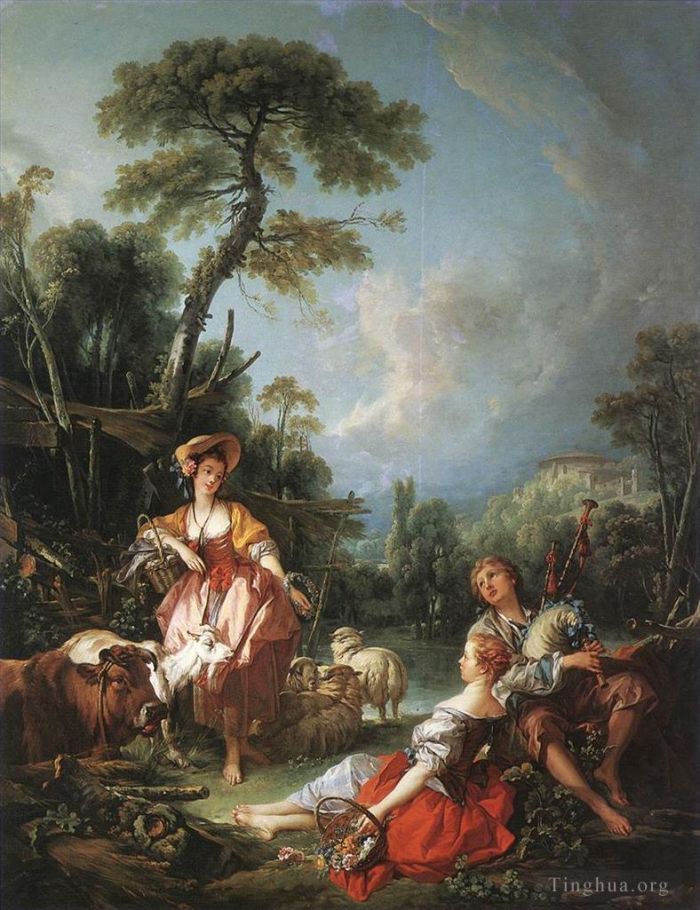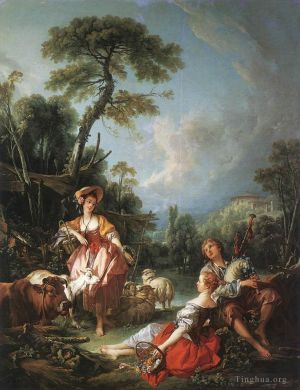A Summer Pastoral
Francois Boucher
- Price: Price on Request
- Art Type: Oil Painting
- Size:
- English Comments: 0
- International Comments: 0
- Creating Date:
- Introduction and Works of Francois Boucher >>
Work Overview
- Summer Pastoral
Francois Boucher
Date: 1749
Style: Rococo
Genre: pastorale
Media: oil, canvas
Dimensions: 259 x 197 cm
With its pendant, P482, the painting is one of Boucher’s most ambitious works in the pastoral mode. Boucher continued the pastoral, utopian mode of Watteau's Fêtes galantes, anchoring them more clearly in an idealised, Italian setting. By exchanging Watteau's contemporary Parisians with idealised shepherds and shjepherdesses, he further removed the scenes from a recognizable contemporary reality, transposing them into an entirely imaginary world. While Watteau produced cabinet pictures, usually of a small size, Boucher often employed the pastoral for large-scale room decorations such as in this case.
The two pictures originally belonged to the Daniel-Charles Trudaine, who worked as governor of the Auvergne, then was put in charge of roads and bridges in France and extended and modernised the network considerably. From 1745 he instigated and supervised the production of a new street atlas of France. Trudaine hung the two paintings in the grand salon on the ground floor of his château at Montigny–Lencoup near Fontainebleau.
The scene was inspired by the theatrical characters of the immensely popular pantomimes of Boucher's friend, Charles-Simon Favart. At the Opéra Comique, where Boucher was both set designer and a keen member of the audience, Favart’s musical dramas combined the Arcadian idealism and aristocratic sensibilities of pastoral poetry with the rustic, sentimental characters of popular theatre. The painting depicts the cousins Lisette and Babette with the little shepherd who wins his sweetheart’s affection and a crown of flowers by serenading her on the bagpipes.
- Copyright Statement:
All the reproduction of any forms about this work unauthorized by Singing Palette including images, texts and so on will be deemed to be violating the Copyright Laws.
To cite this webpage, please link back here.
- >> English Comments
- >> Chinese Comments
- >> French Comments
- >> German Comments
- >>Report
- Hercules and Omfala
- The Visit of Venus to Vulcan
- Geniuses of arts
- The Bird Catchers
- Landscape with Kirschpfluck
- Louise O’Murphy (Blonde Odalisque or Resting Girl or Reclining Girl or Nude on a Sofa)
- The Rape of Europa
- Apollo Revealing his Divinity to the Shepherdess Isse
- Diana Leaving Her Bath
- Venus Consoling Love (The Bath of Venus)
- The Modiste
- Fountain of Love
- The Interrupted Sleep
- The Rising of the Sun
- Unknown sexy touch and sheep
- The Rest on the Flight into Egypt
- 9 The Rising of the Sun
- Venus and Vulcan
- Pan and Syrinx
- The Painter in His Studio
- Vertumnus and Pomona 1740
- Jupiter and Callisto
- Are They Thinking About the Grape
- The Birth and Triumph of Venus
- Young Woman with a Bouquet of Roses
- The Chinese Garden green
- The Forest
- Shepherd lovers
- Morning Coffee (Breakfast)
- The Bridge
- Adoration of the Shepherds
- Madame Bergeret
- River Landscape with Ruin and Bridge
- Portrait of a Lady with Muff
- Leda and swan
- The Mill
- Venus triumf
- Landscape near Beauvais early
- La Belle Villageoise
- The Vegetable Vendor
- Jupiter In the Guise of Diana
- The Mill warm
- Portrait of Carl Gustaf Tessin
- The Toilette of Venus
- La Toilette
- Earth Vertumnus and Pomona
- Allegory of music
- The Love Letter
- Birth of Venus
- Vertumnus and Pomona 1620
- Woman s Head
- Rinaldo and Armida
- Landscape with the brother
- Boucher Francois Morning Coffee
- Portrait of the Marquise de Pompadour
- Diana getting out of her ba
- Dianas Return from the Hunt
- The Chinese Garden
- Vulcan Presenting Venus with Arms for Aeneas
- Young Woman with a Bouquet of Roses Francois Boucher
- Madame de Pompadour
- Madame de Pompadour
- An Autumn Pastoral
- Allegory
- A Summer Pastoral
- Madame Bergeret part
- Amor a prisoner
- Vertumnus and Pomona
- The Interrupted Sleep
- Leda and the Swan
- Swan and nudes
- Shepherd and Shepherdess Reposing
- Portrait of the artist wife
- The Setting of the Sun
- The Enchanted Home A Pastoral Landscape Surmounted by Cupid
- The Love Letter pink
- Hercules and Omfala dark
- Pastoral erotica
- Odalisque
- Putti with Birds
- The Bath of Venus
- St Peter Invited to Walk on the Water
- Diana and Endymion
- Mars and Venus
- The Triumph of Venus
- The Abduction of Europe
- Lady with an Umbrella
- The Education Cupid
- Seated Nude









 Singing Palette
Singing Palette